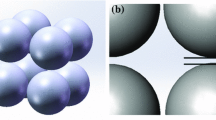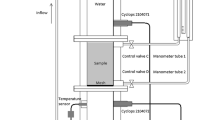Abstract
A new analytical derivation for momentum transport during laminar flow through granular porous media is discussed and some of its implied results described. In the very low Reynolds number regime fully developed laminar flow is assumed and in the higher laminar Reynolds number regime the Forchheimer (non-Darcy) effect is modelled through reference to form drag induced by the solid constituents of the porous medium. The results are compared to the Ergun equation, which is empirically based on experimental measurements, and the correspondence is shown to be remarkably close.
Similar content being viewed by others
Abbreviations
- A :
-
Ergun equation linear term coefficient
- A p :
-
cross-sectional pore area
- B :
-
Ergun equation non-linear term coefficient
- d :
-
microscopic characteristic length
- d x :
-
total tortuous flow length within RUC,V f /A p
- d s :
-
solid cube side width
- e q :
-
streamwise unit vector,q/q
- F :
-
microscopic shear factor
- f :
-
parallel plate friction factor
- g :
-
gravitational body force per unit mass
- I :
-
shear force in RUC
- K :
-
Darcy hydrodynamic permeability
- p :
-
pressure
- p f :
-
〈p〉 f
- q :
-
magnitude ofq
- q :
-
specific discharge, 〈v〉
- Re‖ :
-
parallel plate pore Reynolds number, 2ρv p (d−d s )/Μ
- Re qs :
-
cube Reynolds number,ρqd s /Μ
- S :
-
surface area
- S fs :
-
fluid solid interface
- t :
-
time
- V f :
-
fluid filled ‘void’ volume with RUC
- V s :
-
solid volume within RUC
- V 0 :
-
total volume of RUC
- v :
-
fluid velocity field withinV f
- v i :
-
fluid velocity at streamline inflection point
- v f :
-
intrinsic average velocity withinV f , 〈v〉 f
- v p :
-
cross-sectional mean fluid speed in streamwise pore section
- v ⊥ :
-
cross-sectional mean fluid speed in transverse pore section
- ε :
-
porosity (void fraction),V f /V 0
- Μ :
-
fluid dynamic viscosity
- Ν :
-
normal vector on solid surface and pointing into fluid
- ρ :
-
fluid mass density
- Φ :
-
generic variable
- χ :
-
pore structure tortuosity
- ·:
-
tensor inner product
- 〈Φ〉:
-
volumetric phase average ofΦ,
$$\frac{1}{{V_0 }}\iiint_{V_f } {\phi {\text{d}}V}$$ - 〈Φ〉 f :
-
volumetric intrinsic phase average ofΦ,
$$\frac{1}{{V_f }}\iiint_{V_f } {\phi {\text{d}}V}$$ - \(\mathop \phi \limits^ \circ\) :
-
deviation,Φ−〈Φ〉 f
- ⊥:
-
as subscript, transverse pores
- ‖:
-
as subscript, streamwise pores
- Μ :
-
as subscript, due to viscous shear
- c :
-
as subscript, critical value
- D :
-
as subscript, downstream side of solid cube
- f :
-
as subscript, fluid phase
- f s :
-
as subscript, fluid-solid interface
- U :
-
as subscript, upstream side of solid cube,
- 0:
-
as subscript, low Reynolds number limit
- ∞:
-
as subscript, high Reynolds number limit
References
Bear, J., and Bachmat, Y., 1986, Macroscopic modelling of transport phenomena in porous media. 1: The continuum approach,Transport in Porous Media 1, 213–240.
Bird, R. B., Stewart, W. E., and Lightfoot, E. N., 1960,Transport Phenomena, John Wiley, New York.
Chang, H.-C., 1983, Effective diffusion and conduction in two-phase media: a unified approach,AIChEJ 29(5), 846–853.
Churchill, S. W., and Usagi, R., 1972, A general expression for the correlation of rates of transfer and other phenomena,AIChEJ 18(6), 1121–1128.
Dagan, G., 1989,Flow and Transport in Porous Formations, Springer-Verlag, Berlin.
Du Plessis, J. P., 1992, High Reynolds number flow through granular porous media, in T. F. Russelet al. (eds),Computational Methods in Water Resources IX, Vol. 2: Mathematical Modeling in Water Resources, Computational Mechanics Publications, Southampton, pp. 179–186.
Du Plessis, J. P. and Masliyah, J. H., 1988, Mathematical modelling of flow through consolidated isotropic porous media,Transport in Porous Media 3, 145–161.
Du Plessis, J. P. and Masliyah, J. H., 1991, Flow through isotropic granular porous media,Transport in Porous Media 6, 207–221.
Dullien, F. A. L., 1979,Porous Media Fluid Transport and Pore Structure, Academic Press, London.
Joseph, D., Nield, D., and Papanicolau, G., 1982, Non-linear equation governing flow in a saturated porous medium,Water Resour. Res. 18, 1049–1052.
MacDonald, I. F., El-Sayad, M. S., Mow, K., and Dullien, F. A. L., 1979, Flow through porous media — the Ergun equation revisited,Ind. Eng. Chem. Fundam. 18(3), 199–208.
Mei, C. C. and Auriault, J.-L., 1991 The effect of weak inertia on flow through a porous medium,J. Fluid Mech. 222, 647–663.
Rudraiah, N., Veerabhadraiah, R., Chandrasekara, B. C., and Nagaraj, S. T., 1979,Some Flow Problems in Porous Media, PGSAM Series vol. 2, Department of Mathematics, Central College, Bangalore University, India.
Ruth, D. and Suman, R., 1992, The role of microscopic cross flow in idealized porous media,Transport in Porous Media 7, 103–125.
Svetkovic, V. D., 1986, A continuum approach to high velocity flow in a porous medium,Transport in Porous Media 1, 63–97.
Author information
Authors and Affiliations
Rights and permissions
About this article
Cite this article
Prieur Du Plessis, J. Analytical quantification of coefficients in the Ergun equation for fluid friction in a packed bed. Transp Porous Med 16, 189–207 (1994). https://doi.org/10.1007/BF00617551
Received:
Revised:
Issue Date:
DOI: https://doi.org/10.1007/BF00617551




